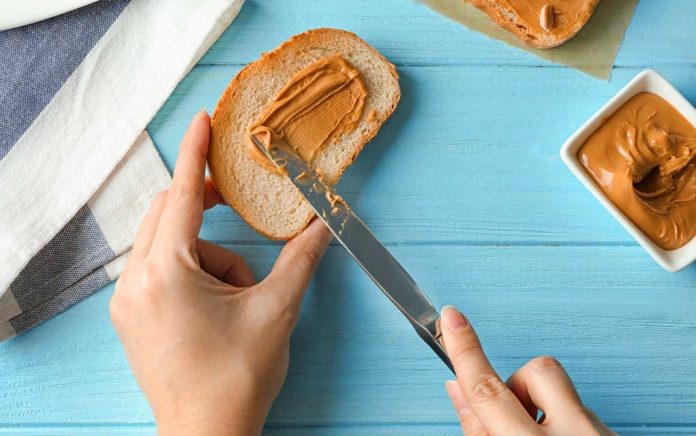
There is a lot of disagreement as to whether or not peanut butter is healthy. Some experts think it will kill your metabolism and lead to inflammation. Others claim it is a nutritious pantry essential that supports an active lifestyle. Confused?
The fact is, healthy or not, peanut butter is a dietary staple for the majority of us. And why wouldn’t it be? It’s cheap, widely available and nutritious. But in recent years, peanut butter has started to develop a bad reputation with some nutritionists, dietitians and naturopaths. Let’s take a look at both sides:
THE GOOD
Protein dense.
Peanuts contain a lot of easily digestible protein. For vegetarians and vegans, peanut butter can be a part of a tasty and well-rounded diet. (Even if you’re carnivorous, throwing a spoonful into your banana cinnamon smoothie isn’t a bad idea.) Each serving of peanut butter (2 tablespoons) has around 8 grams of protein. If you are lacking vegetarian protein in your diet, peanut butter is an easy answer.
Loaded with healthy fats.
If you haven’t heard, we are embracing healthy fats now. Gone are the bland, fatless diets of the 90s. Fats like avocado, olive oil, flaxseed and—you guessed it—peanut butter are being lauded by nutritionists instead of stigmatized. With over 12 grams of unsaturated fat and 3 grams of saturated, the healthy fats in peanut butter can increase satiety, stabilize blood sugar (more on that next) and even support a healthy weight.
PB can balance blood sugar.
There is a reason that peanut butter and chocolate go together so well. The fats and protein in the butter slow the absorption of sugar in the bloodstream, making it a smart treat (especially if you make a low sugar version at home). In fact, one study showed that consumption of peanut butter at breakfast helped control hunger and blood sugar levels throughout the day in a group of pre-diabetics.
Nut-free.
If you have problems digesting nuts, peanut butter is still a valid option since peanuts are not a nut at all. Of course, peanuts are a common allergen themselves, so be cautious if you’re prone to allergies.
THE BAD
Watch out for aflatoxins.
Ah, herein lies the great peanut butter debate. Peanuts are prone to developing a type of toxic mold known as aflatoxins. Aflatoxins, in large quantities, can be highly carcinogenic. In small quantities, they can cause sometimes minute and unaddressed side effects like depression. Most peanuts become moldy because they are grown on the moist ground then stored in vast, poorly ventilated silos. Valencia peanuts and Jungle peanuts are two varieties that are typically grown higher up off the ground, which makes mold less prevalent. If you are concerned about mold but love peanuts, those varieties are your best bet. Buy them in bulk and make your own peanut butter in a food processor at home to ensure freshness.
High in Omega 6.
There is a great imbalance in our dietary consumption of unsaturated fats, namely omega 3 fatty acids versus omega 6 fatty acids. The ideal ration of omega 6 to omega 3 is 2:1. But realistically, due to our high consumption of vegetable oils, Americans regularly consume well over 16 servings of omega 6 for every serving of omega 3! This is causing major and chronic inflammation. And eating omega 6-rich peanut butter only adds to the issue. Improve your omega 3 levels by taking a fish oil supplement and using raw flaxseed oil on the regular and consume peanut butter sparingly if you feel like your levels are probably out of whack.
Beware of sugar and over-processing.
Many big brands of peanut butter are loaded with sugar and fully hydrogenated oils. That’s right, trans fats. Did you think you didn’t have to worry about those anymore? Well, they’re still around somehow. They are everywhere. To avoid them, read the labels and buy peanut butter with 2 ingredients or less: peanuts and salt. That’s all it needs to be. Or better yet, make it at home. It only takes 10 minutes.
They’re a legume.
While this isn’t necessarily bad, it is for some people. Legumes can be particularly challenging to digest for some, which can result in mild bloating or gas at the very least. For the Paleo crowd, legumes are off-limits. Because they are so high in lectins, which can cause inflammatory issues like leaky gut, this diet kicks them to the same curb as grains. Unfortunately, nuts and grains are also high in intestinally damaging lectins. Luckily, sprouting greatly reduces lectin content, so sprout your nuts, seeds, legumes and grains whenever you can.
CONCLUSION
Only you can decide whether or not peanut butter is a healthy food for you. Yes, chocolate peanut butter cups are delicious, but you know your body better than anybody. If peanuts make you feel great, keep them on your shopping list. But, if you notice even the slightest bit of bloating or lack of energy after consuming peanut products, you may be better off without them.
This post originally appeared on Care2.com.




